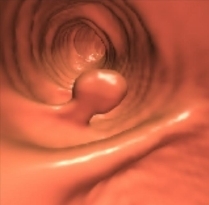Virtual colonoscopy boosts screening compliance
by
Brendon Nafziger, DOTmed News Associate Editor | November 15, 2011

Doctors are divided on the merits of virtual colonoscopy, but a new study suggests it can boost the number of people willing to undergo colon cancer screening.
In a study published online Tuesday in The Lancet, Dutch researchers found patients invited for screenings with virtual colonoscopy, also called computed tomographic colonography, were 55 percent more likely to undergo the procedure than those invited for traditional colonoscopies. True, CT colonographies were slightly less effective in picking out abnormal masses than conventional colonoscopies. However, because of the increased participation, the two modalities were pretty much tied for effectiveness, as the number of masses found per 100 people invited to screening was about the same for each group.
"Participation in colorectal cancer screening with CT colonography was significantly better than with colonoscopy, but colonoscopy identified significantly more advanced neoplasia per 100 participants than did CT colonography," write the authors, led by Dr. Esther M. Stoop, with Erasmus University Medical Center in Rotterdam, and Dr. Margriet C. de Haan, with the Academic Medical Center in Amsterdam.
Virtual colonoscopy involves taking CT scans of the colon and rectum and creating 3-D images to look for cancer and other abnormalities. Many radiologists believe the scans can increase screenings rates for at-risk patients who might be reluctant to undergo traditional colonoscopies, which require snaking a tube with a camera at the end through the colon.
And, in the current study, that's what the researchers seem to have found.
In the study, researchers invited people from the general population in the Netherlands, aged 54-70, to undergo colon cancer screening, randomly assigning them to receive a CT scan of the colon or a colonoscopy. They found that while 22 percent of those invited to receive a colonoscopy participated (1,276 out of 5,924), 34 percent of those invited for a CT colonography did (982 out of 2,920).
For patients in the CT colonography group, if a mass bigger than 10-millimeters was detected, they were recommended for a follow-up colonoscopy. Patients with smaller masses were to be monitored for the next three years.
Traditional colonoscopies found significantly more masses. At least one mass, called an advanced neoplasm, was found in 8.7 people per 100 participants, versus virtual colonoscopy, which found at least one mass in 6.1 people per 100 participants. However, because of the greater participation rates in the virtual group, it was pretty much a wash: the number of invitees with masses was 1.9 per 100 invitees in the colonoscopy group, versus 2.1 per 100 invitees in the virtual colonoscopy group.
Also, the lower diagnostic yield in the study might have been caused by the trial methods, such as the "non-cathartic bowel preparation, the primary two-dimensional reading approach and the different handling of small polyps (6-9 mm)," according to Perry J. Pickhardt, with University of Wisconsin-Madison, who wrote an editorial accompanying the article.
"When an approach of cathartic preparation with oral contrast tagging and primary three-dimensional reading is applied, CT colonography is equivalent or slightly better than optical colonoscopy for the detection of advanced neoplasia," he said.
The researchers of the present study noted that cost-effectiveness of the two modalities was not analyzed. Previously, critics of virtual colonoscopy have pointed out that the scans can pick up extracolonic findings, which might involve costly further testing or treatments, even though the detected abnormality might never pose a problem for the patient.
Citing lack of evidence, in 2009 the Centers for Medicare and Medicaid Services denied coverage for general screening.
|
|
|
You Must Be Logged In To Post A Comment
|
